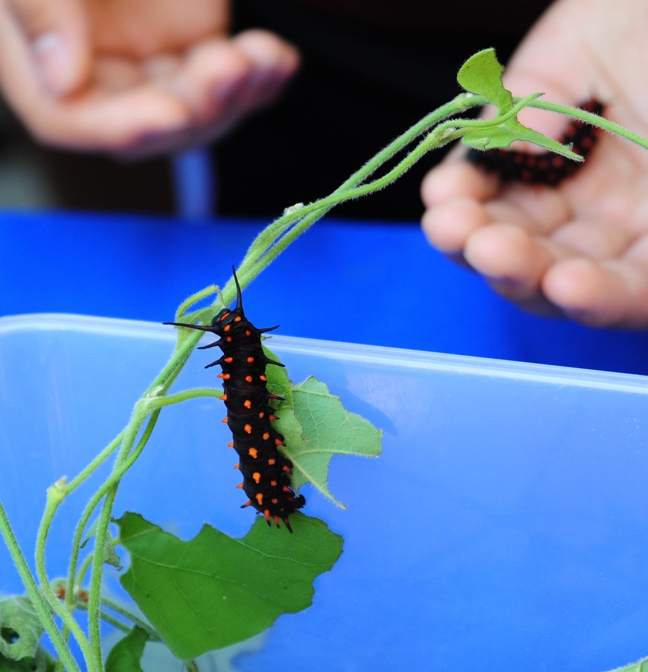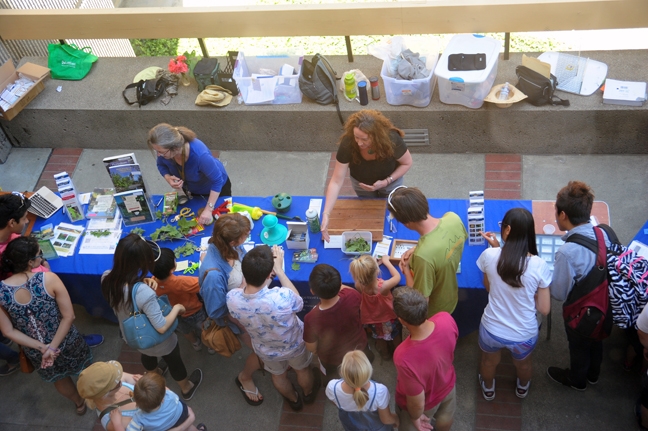Visitors to the UC Statewide Integrated Pest Management Program (UC IPM) display in front of Briggs Hall at the 101st annual Picnic Day last Saturday at the University of California, Davis, got a close look at the Pipevine Swallowtail caterpillar.
While the visitors watched or held them, the other caterpillars kept busy, munching on the leaves of their host plant, the pipevine.
Butterfly expert Art Shapiro, distinguished professor in the UC Davis Department of Evolution and Ecology, has seen lots of Pipevine Swallowtails (Battus philenor) already this year. "There are plenty," he said today. "Don't eat 'em; they're quite poisonous."
Both the caterpillar and the adult are poisonous. The caterpillars of the Pipevine Swallowtail feed on the poisonous host plant, Aristolochia, also known as the pipevine, Dutchman's pipe or birthwort. It contains the lethal toxin aristolochic acid.
Nevertheless, the black caterpillars turn into beautiful adults. Found throughout North America and Central America, they are black with iridescent blue hind wings. Their wingspan can exceed three inches.
"The Pipevine Swallowtail flies from late winter (February-March) to autumn (October, occasionally November) but is much more numerous before the 4th of July than later; typically it has two large flights followed by stragglers the rest of the season, often with a 'blip' upward in August," Shapiro writes on his website. "Usually the host plant stops growing in June, and thereafter there are no sites suitable for egg-laying--unless there is a local catastrophe (usually fire, though weed-whacking will do). Then the plants regenerate rapidly, producing new growth in the off-season, and any females around at the time quickly find and make use of the new shoots. Adults routinely live a month or so."
"This species is warningly colored and inedible to vertebrate predators," Shapiro points out. "It derives its protection from the toxic aristolochic acids produced by the host, which it sequesters; females even pass these along to the eggs, which are also protected (and are brick red, laid in bunches of up to 20, and quite conspicuous)."
"Adults are eager visitors to many flowers, including Wild Radish, California Buckeye, Blue Dicks, Ithuriel's Spear, and Yerba Santa," Shapiro notes. "In summer they regularly nectar at Yellow Star Thistle when there are no native plants in bloom."
We've seen many of the Pipevine Swallowtails fluttering around in the UC Davis Arboretum and gathering nectar from butterfly bushes.
A word of warning from Shapiro: "Don't eat 'em; they're quite poisonous."
Attached Images:

The Pipevine Swallowtail caterpillar is black with red spines. This one was displayed at the UC Davis Picnic Day. (Photo by Kathy Keatley Garvey)

The human touch: young fingers touch the Pipevine Swallowtail caterpillar. (Photo by Kathy Keatley Garvey)

An adult Pipevine Swallowtail nectaring on Jupiter's Beard. (Photo by Kathy Keatley Garvey)

A bird's eye view of the UC IPM display in front of Briggs Hall during the 101st annual campuswide Picnic Day. Staffing the tables are Extension entomologist specialist emeritus Mary Lou Flint (left), former associate director for urban and community IPM and Karey Windbiel-Rojas who replaced Flint. (Photo by Kathy Keatley Garvey)